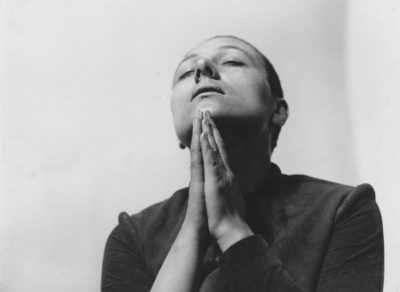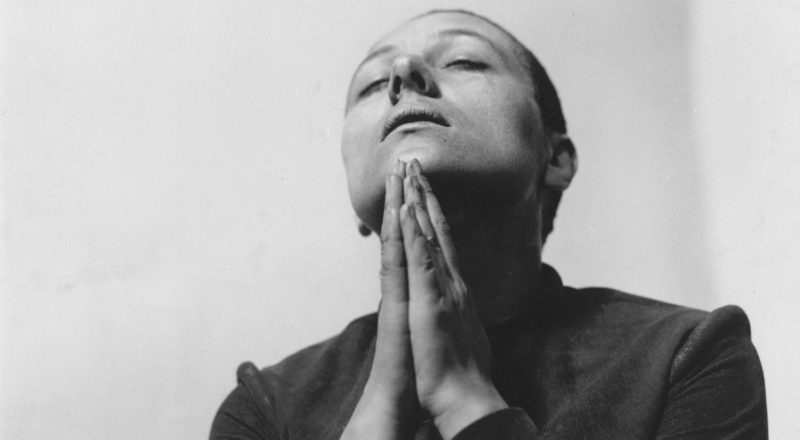INTERVIEW: Bringing ‘Voices of Light’ to silent ‘Joan of Arc’
The Passion of Joan of Arc is a legendary silent film from 1928 that continues to amaze modern-day audiences. Viewers likely first fell in love with the restored classic thanks to the Criterion Collection and Janus Films, and now they can fall in love with the story and its evocative imagery all over again.
Composer Richard Einhorn has created a choral and orchestral work to accompany the film. Einhorn’s Voices of Light is performed by the ensemble Anonymous 4, and it is paired with screenings of the film this week at New York City’s Film Forum.
The movie tells the infamous story of Joan of Arc (Falconetti), the historical woman who faced many obstacles in her life. She was seen as a mystic, a warrior, a heretic and a saint. Carl Theodor Dryer’s film uses actually testimony from Joan of Arc’s trial and captures a mesmerizing performance from Falconetti. Dryer also rebuilt the city of Rouen for the lavish production, but interestingly, the director opted more for closeups (a rarity at this time in film history) rather than sweeping shots of the cityscape he helped to create.
Recently, Hollywood Soapbox spoke with Einhorn about his composition. Here’s what he had to say.
On the impetus for the project …
“I wasn’t really planning on writing anything for a silent film. Namely what I was interested in was doing a large piece on the subject of religion, and by sheer accident, I managed to come across this great silent movie, The Passion of Joan of Arc, in a movie binder in a museum film archives. And I realized it was the perfect vehicle for what I had in mind, and so I went with it and wrote a large score for orchestra, chorus, voices, digital sampler, basically threw the kitchen sink at it.”

On his initial reactions of seeing the film …
“Well, when I first saw the movie, I was overwhelmed. I thought it was one of the best films I had ever seen in my life, and I had never heard of it. So one of the things I wanted to do was make sure that as many people as possible could experience the film as they could. I just really, really wanted to get this movie and this project out there because I thought it was a great movie. Nobody had seen it, and it really deserved to be seen.
“And basically that’s one of the most exciting things about this project. What’s happened now is that when it was released originally by Criterion and by Janus Films I guess around 15-16 years ago, it was in very, very good shape. They had found an extremely good print of this film by sheer accident in a mental institution, and they had basically cleaned that print up. And it looked great, but what they’ve done recently and what we’re going to see now is a digitally restored print, which is absolutely spectacular. It looks like it was made yesterday — a really, really beautiful job.”
On how he developed his unique Voices of Light composition …
“I saw the movie. I saw it silently projected against a wall, and when it was done, I knew immediately what I wanted to do, and that was to write music with words taken from the writings of Medieval female mystics from Joan of Arc’s time and earlier. The words would comment on the movie and Joan of Arc’s life. It was very, very obvious what to do. It rarely happens, but in this case it did. And I was really excited about it, and the score, to compose the music didn’t take very long at all. It took a long time to get the project off the ground, but it only took about three-and-a-half months to write the music.”
On the uniqueness of The Passion of Joan of Arc …
“Well, this is a very, very unusual movie. It doesn’t look like any silent movie you’ve ever seen before, and it looks so modern and so unusual — the camera angles, the editing, the acting, even the makeup. There’s no makeup in the movie. Everybody deliberately uses zero makeup in the film, so when you look at the whole thing together, it’s very obvious that it doesn’t need a ‘film score.’ That’s the last thing that this project needs.
“I’ve composed about 16 or 17 feature-film scores and hundreds of documentaries, but this one really I approached very differently. The only thing I did was I divided the movie up into 15 sections, and each one of those became a piece of music, an individual piece of music. And the only thing that I cared about and the only thing that I care about when it’s performed live is that the music begin and end at the beginning and ending of those long sections. Some of these sections go on for 10-11 minutes, but what happened internally was of no interest to me.
“What I was trying to do was write my own response, my own artistic response to Dryer’s work of art and not really write a ‘film score.’ If it had been a different movie, maybe I would have done that, but not this one. This one was very, very special.”
On the response he has heard from audience members …
“Well, I can only tell you what the response has been typically to it live. … And it doesn’t really matter where we perform it. … The reaction is almost always been the same, which is sheer, stunned silence at the end. It simply is one of the most amazing movies I’ve ever seen in my life and that most people have ever seen. It just simply overwhelms you, and it’s beautiful. It’s heartbreaking. Parts of it are funny. Parts of it are horrific. Parts of it are transcendent, and the audience is just simply typically overwhelmed. And I hope that people come to the screening and enjoy it because what I like to say is that if you have a list of 10 favorite movies, if you go to the screening, you’re going to have a list of 11 favorite movies, guaranteed. It really is that great.”
By John Soltes / Publisher / John@HollywoodSoapbox.com
The Passion of Joan of Arc with Richard Einhorn’s Voices of Light is currently running at New York City’s Film Forum. Click here for more information and tickets.

